

Royal Australian Navy Discussions and Updates - Page 660. Quote: Have you looked at the Danish Knud Rasmussen-class OPV?
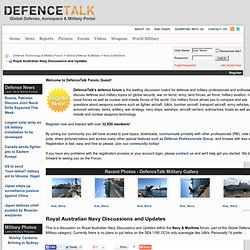
In full load displacement, it is comparable to what the OCV seems intended to be. My reservations on it stem from a lack of helicopter hangar (it does have a helipad & refueling capabilities), a listed range of 3,000 n miles, a max speed of ~17 kts, and accommodations for only ~40 people. The design is apparently ice-strengthened, since the Danes commissioned the class for sovereignty, SAR and EEZ patroling in & around Greenland. They are fitted with two StanFlex container positioned, with room for two additional container slots. While I do not think the design would suit RAN needs 'as is', it certainly could be modified to make it more suitable. While I would not expect the main fitout for the RAN would have all OCV's heavily armed with 76 mm cannon, ESSM, etc. As for modules... Offshore Combatant Vessel. The Navy operated in 2010 four relatively small fleets of vessels for important tasks such as offshore resource protection, border security, hydrographic and oceanographic environmental assessments and clearing sea mines.

This significantly increases whole-of-life ownership costs and personnel overheads. Smaller vessels also have less seagoing capacity and a reduced scope for installing more capable sensor or weapons systems over time. The Government therefore decided that Defence will develop proposals to rationalise the Navy's patrol boat, mine counter measures, hydrographic and oceanographic forces into a single modular multirole class of around 20 Offshore Combatant Vessels combining four existing classes of vessels. This has the potential to provide significant operational efficiencies and potential savings. The new vessels will be larger than the current Armidale class patrol boats, with an anticipated displacement of up to 2,000 tonnes. Semaphore: May 2010. The future Offshore Combatant Vessel will be able to undertake offshore and littoral warfighting roles, border protection tasks, long-range counter-terrorism and counter-piracy operations, support to special forces, and missions in support of security and stability in the immediate neighbourhood.Defending Australia in the Asia Pacific Century: Force 2030 [1] To minimise cost and personnel overheads, the Government has directed that Defence develop proposals to rationalise the Royal Australian Navy's (RAN) patrol boat, mine countermeasures (MCM), hydrographic and oceanographic forces into a single modular class of around 20 offshore combatant vessels (OCV).
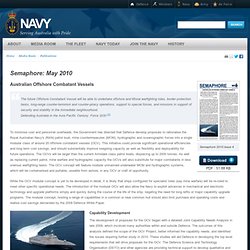
This initiative could provide significant operational efficiencies and long term cost savings, and should substantially improve seagoing capacity as well as flexibility and deployability for future operations. The OCVs will be larger than the current Armidale class patrol boats, displacing up to 2000 tonnes. Capability Development. A Littoral Combat Ship for Sea Base Defense. SEA1180 - Australian Offshore Combatant Vessel (OCV)
Planning and design[edit] Instead of being capable of performing all roles simultaneously, the ships will have a modular mission payload system like the Standard Flex system used by the Danish Navy, or the system used by the United States Navy's Littoral Combat Ships: mission-specific equipment will be fitted to containerised modules, which can be exchanged for different modules when the ship needs to change roles.[1][4][5] The use of containerised modules means that equipment can be upgraded without taking the ships out of service for refit, and if necessary can be fitted to requisitioned civilian vessels.[2] The cost in developing and implementing the modular system is predicted to be offset by the savings in the areas of maintenance (having to purchase and maintain stocks to repair four different designs), personnel (having to retrain sailors when they transfer to a new ship), and administration.[1][2] International cooperation[edit] Proposed designs[edit] Role[edit]
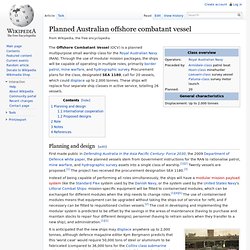
Future of the Royal Navy. At the beginning of the 1990s the Royal Navy was a force designed for the Cold War: with its three small aircraft carriers and a force of anti-submarine frigates and destroyers, its main purpose was to search for – and in the event of an actual declaration of war, to destroy – Soviet submarines in the North Atlantic.
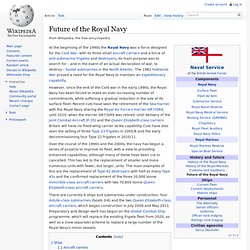
The 1982 Falklands War proved a need for the Royal Navy to maintain an expeditionary capability. However, since the end of the Cold war in the early 1990s, the Royal Navy has been forced to make an ever increasing number of commitments, while suffering a gradual reduction in the size of its surface fleet. Recent cuts have seen the retirement of the Sea Harrier with the Royal Navy sharing the Royal Air Force's Harrier GR7/GR9, until 2010, when the Harrier GR7/GR9 was retired. Until delivery of the Joint Combat Aircraft (F-35) and the Queen Elizabeth-class carriers Britain will have no fixed-wing carrier strike capability. Navy's New Minehunter Can't See or Stop Mines. Photo: U.S.
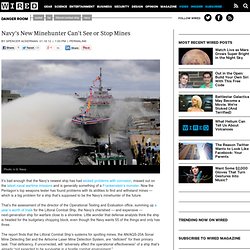
Navy It’s bad enough that the Navy’s newest ship has had wicked problems with corrosion, missed out on the latest naval wartime missions and is generally something of a Frankenstein’s monster. USN Littoral & Mine Warfare Overview.